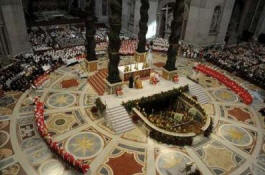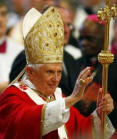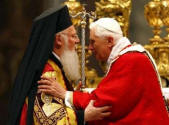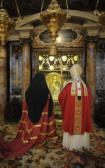|
Pope Benedict XVI- Homilies |
 "Going to Rome Is for Paul the Expression of His Mission" "Going to Rome Is for Paul the Expression of His Mission"
Papal
Homily for the Solemnity of Sts. Peter and Paul
St. Peter's Basilica
H.H. Benedict XVI
June 29, 2008
www.zenit.org
Here is a translation
of the homily Benedict XVI gave via satellite Sunday at the closing
Mass of the 49th International Eucharistic Congress. The homily was
given in English and French.
Your Holiness and
fraternal Delegates,
Lord Cardinals,
Venerable brothers in the episcopate and priesthood,
Dear brothers and sisters
From the earliest times, the Church of Rome has celebrated the
solemnity of the great apostles Peter and Paul as a single feast
on the same day, June 29. Through their martyrdom, they became
brothers; together, they are the founders of the new Christian
Rome. They are sung of as such in the hymn of the second
vespers, which goes back to Paulinus of Aquileia (+806): "O Roma
felix -- Oh happy Rome, adorned with the crimson of the precious
blood of such great princes, you surpass every beauty of the
world, not by your own merit, but trough the merit of the saints
whom you have killed with bloody sword". The blood of martyrs
does not call for revenge -- but reconciles. It does not present
itself as an accusation but as a "golden light," according to
the words of the hymn of the first vespers. It presents itself
as the power of love which overcomes hate and violence,
founding, in this way, a new city, a new community.
By their martyrdom, they -- Peter and Paul -- are now part of
Rome. Through martyrdom, even Peter became a Roman citizen
forever. Through their martyrdom, through their faith and their
love, the two apostles show us where true hope lies, and are the
founders of a new kind of city, which must again and again form
itself in the midst of the old city of man, which continues to
be threatened by the opposing forces of the sin and egotism of
men.
By virtue of their martyrdom, Peter and Paul are in reciprocal
relationship forever. A favorite image of Christian iconography
is the embrace of the two apostles on the way to martyrdom. We
can say that their martyrdom itself, in its deepest reality, is
the realization of a fraternal embrace. They die for the one
Christ and, in the witness for which they give their lives, they
are one. In the writings of the New Testament, we can, so to
speak, follow the development of their embrace, this unity in
witness and in mission.
Everything starts when Paul, three years after his conversion,
goes to Jerusalem "to consult Cephas" (Galatians 1:18). Fourteen
years later, he again goes up to Jerusalem to explain "to the
most esteemed persons" the Gospel that he preaches in order so
that he might not run the risk of "running, or having run, in
vain" (Galatians 2:1f). At the end of this meeting, James,
Cephas and John give him their right hands, thus confirming the
communion that unites them in the one Gospel of Jesus Christ
(Gal 2:9). A beautiful sign of this growing interior embrace,
which develops despite the difference in temperaments and in
tasks, I find in the fact that the co-workers mentioned at the
end of the First Letter of St. Peter -- Silvanus and Mark --
were equally close co-workers of St. Paul. This having of the
same co-workers makes the communion of the one Church, the
embrace of the great apostles, visible in a very concrete way.
Peter and Paul met each other at least twice in Jerusalem; at
the end their paths take them to Rome. Why? Was this perhaps
more than just pure chance? Is there perhaps a lasting message
in it? Paul arrived in Rome as a prisoner, but at the same time
as a Roman citizen who, after his arrest in Jerusalem, as a
Roman citizen appealed to the emperor, to whose tribunal he was
brought. But in a more profound sense, Paul came to Rome
voluntarily. Through the most important of his letters, he had
already drawn close to this city interiorly: to the Church in
Rome, he had addressed the writing which, more than any other,
is the synthesis of his whole proclamation and his faith. In the
opening salutation of the letter, he says that the whole world
speaks of the faith of the Christians of Rome and that this
faith, therefore, was known everywhere as exemplary (Romans
1:8). And then he writes: "I do not want you to be unaware,
brothers, that I often planned to come to you, though I was
prevented until now" (1:13). At the end of the letter he comes
back to this theme, now speaking of a plan to travel to Spain.
"When I go to Spain I hope to see you when I pass through and to
be helped by you on my way to that region, after having enjoyed
your presence for a little while" (15:24). "And I know that,
having come to you, I shall come in the fullness of Christ's
blessing" (15:29). There are two things made evident here: Rome
is for Paul a stage on the way to Spain, that is -- according to
his conception of the world -- towards the extreme end of the
earth. He considers his mission to be the fulfillment of the
task received from Christ, the bringing of the Gospel to the
very ends of the world. Rome is along this route. While Paul
usually only goes to places where the Gospel had not yet been
announced, Rome is an exception. There he finds a Church whose
faith the world speaks about. Going to Rome is part of the
universality of his mission as one sent to all peoples. The way
to Rome, which, already before his external trip, he had
traveled interiorly with his letter, is an integral part of his
task of bringing the Gospel to all peoples -- of founding the
Church, catholic and universal. Going to Rome is for him the
expression of his mission's catholicity. Rome must make the
faith visible to the whole world, it must be the meeting place
in the one faith.
But why did Peter go to Rome? About this the New Testament does
not say anything directly. But it gives us some indication. The
Gospel of St. Mark, which we may consider a reflection of the
preaching of St. Peter, is intimately oriented towards the
moment when the Roman centurion, facing the death of Christ on
the cross, says, "Truly this man was the Son of God!" (15:39).
At the cross the mystery of Jesus Christ is revealed. Beneath
the Cross the Church of the gentiles is born: the centurion of
the Roman execution squad recognizes the Son of God in Christ.
The Acts of the Apostles describe the episode of Cornelius, the
centurion of the Italic cohort, as a decisive stage for the
entrance of the Gospel into the pagan world. Following a command
of God, he sends someone to get Peter, and Peter, also following
a divine order, goes to the centurion's house and preaches.
While he is speaking, the Holy Spirit descends on the gathered
domestic community and Peter says: "Can anyone withhold the
water for baptizing these people, who have received the holy
Spirit even as we have?" (Acts 10:47).
Thus, in the Council of the Apostles, Peter becomes the
intercessor for the Church of the pagans who do not need the Law
because God "has purified their hearts with faith" (Acts 15:9).
Certainly, in the Letter to the Galatians, Paul says that God
gave strength to Peter for the apostolic ministry among the
circumcised, and to Paul himself, the ministry among the pagans
instead (Gal 2:8). But this assignment could be in force only as
long as Peter remained with the 12 in Jerusalem in the hope that
all of Israel would adhere to Christ. In the face of later
developments, the 12 recognized the time in which they too must
go forth into the world to announce the Gospel to it. Peter who,
following divine order, had been the first to open the door to
pagans, now leaves the leadership of the Christian-Jewish Church
to James the Less, in order to dedicate himself to his true
mission: to the ministry of the unity of the one Church of God
made up of Jews as well as pagans. The desire of Paul to go to
Rome highlights above all, as we have seen, the word "catholica"
["catholic"] among the characteristics of the Church.

St. Peter's journey to Rome, as representative of the peoples of
the world, is above all associated with the word "una" ["one"]:
he has the task of creating the "unity" of the "catholica," of
the Church made up of Jews and pagans, the Church of all
peoples. And this is the permanent mission of Peter: to make
sure that the Church never identifies herself with any one
nation, any one culture or any one state. That it may always be
the Church of all. That it may unite mankind beyond every
frontier and, amidst the divisions of this world, make God's
peace present, the reconciling power of his love. Due to
technology that is now the same everywhere, due to the global
information network, and due also to the linking of common
interests, there are new modes of unity in the world, which have
caused the explosion of new oppositions and given new impetus to
old ones. In the midst of this external unity, based on material
things, we have all the more need of interior unity which comes
from the peace of God - the unity of all those who, through
Jesus Christ, have become brothers and sisters. This is the
permanent mission of Peter, as well as the special task
entrusted to the Church of Rome.
Dear confreres in the Episcopate! I wish now to address those of
you who have come to Rome to receive the pallium as the symbol
of your rank and your responsibility as archbishops in the
Church of Jesus Christ. The pallium is woven from the wool of
the sheep that the Bishop of Rome blesses every year on the
Feast of Peter's Chair, thus setting them apart, so to speak, to
be a symbol for the flock of Christ, over which you preside.
When we put the pallium on our shoulders, this gesture reminds
us of the Shepherd who puts the lost sheep upon his shoulders --
the lost sheep who by himself can no longer find the way home --
and takes him back to the sheepfold. The Fathers of the Church
saw in this sheep the image of all mankind, of human nature in
its entirety, which is lost its and can no longer find the way
home. The Shepherd who takes the sheep home can only be the
Logos, the eternal Word of God himself. In the Incarnation, he
placed us all -- the sheep who is man -- on his shoulders. He,
the eternal Word, the true Shepherd of mankind, carries us; in
his humanity he carries each of us on his shoulders. On the way
of the Cross, he carried us home, he takes us home. But he also
wants men who can "carry" together with him. Being a shepherd in
the Church of Christ means taking part in this task, which the
pallium commemorates. When we put it on, he asks us: "Will you
also carry, together with me, those who belong to me? Will you
bring them to me, to Jesus Christ?" What comes to mind next is
the order Peter received from the Risen Christ, who links the
command, "Feed my sheep" inseparably with the question, "Do you
love me? Do you love me more than others do?" Every time we put
on the pallium of the shepherd of Christ's flock, we should hear
this question, "Do you love me?" and we must ask ourselves about
that "more" of love that he expects from the shepherd.
Thus the pallium becomes a symbol of our love for the Shepherd
Christ and our loving together with him -- it becomes the symbol
of the calling to love men as he does, together with him: those
who are searching, those who have questions, those who are
self-assured and the humble, the simple and the great; it
becomes the symbol of the calling to love all of them with the
strength of Christ and in view of Christ, so that they may find
him, and in him, find themselves. But the pallium which you will
receive "from" the tomb of Peter has yet another meaning,
inseparably connected with the first. To understand this, a word
from the First Letter of St. Peter may help us. In his
exhortation to priests to feed the flock in the correct way, St.
Peter calls himself a "synpresbęteros" -- co-priest (5:1). This
formula implicitly contains the affirmation of the principle of
apostolic succession: the shepherds who follow are shepherds
like him; together with him, they belong to the common ministry
of the shepherds of the Church of Jesus Christ, a ministry that
continues in them. But this "co-" (in co-priest) has still two
other meanings. It also expresses the reality that we indicate
today by what is said today about the "collegiality" of bishops.
We are all "co-priests." No one is a shepherd by himself. We are
in the succession of the apostles thanks only to being in the
communion of the college in which the college of apostles finds
its continuation. The communion -- the "we" -- of the shepherds
is part of being shepherds, because there is only one flock, the
one Church of Jesus Christ. Finally, this "co-" also refers to
communion with Peter and his successor as a guarantee of unity.
Thus, the pallium speaks to us of the catholicity of the Church,
of the universal communion of shepherd and flock. And it refers
us to apostolicity: to communion with the faith of the apostles
on which the Church is founded. It speaks to us of the
"ecclesia" that is "una," "catholica," "apostolic," and
naturally, binding us to Christ, it speaks to us of the fact
that the Church is "sancta" us that the Church is holy, and that
our work is a service of this holiness.
This brings me back, finally, to St. Paul and his mission. He
expressed the essence of his mission, as well as the most
profound reason for his desire to go to Rome, in Chapter 15 of
the Letter to the Romans, in an extraordinarily beautiful
passage. He knows he has been called "to be a 'leitourgos' of
Christ Jesus for the Gentiles, serving the Gospel of God as a
priest, so that the pagans become an acceptable offering,
sanctified by the holy Spirit" (15:16). Only in this passage
does Paul use the word "hierourgein" -- serving as a priest --
together with "leitourgos" -- liturgist: he speaks of the cosmic
liturgy, in which the world of men itself must become worship of
God, an offering in the Holy Spirit. When the whole world will
have become the liturgy of God, when in its reality it will have
become adoration, then it will have reached its goal, then it
will be whole and saved. And this is the ultimate objective of
St. Paul's apostolic mission and of ours. It is to such a
mystery that the Lord calls us. Let us pray in this hour that he
may help us carry it out in the right way, to become true
liturgists of Jesus Christ. Amen.
[Translation by Joseph G. Trabbic]
 Patriarch's
Homily for Solemnity of Sts. Peter and Paul Patriarch's
Homily for Solemnity of Sts. Peter and Paul
With Benedict XVI's Introduction
St. Peter's Basilica
Orthodox Patriarch Bartholomew I
June 29, 2008
www.zenit.org
The Holy
Father's Introduction to the Patriarch's Homily
Brothers and Sisters,
The great feast of Saints Peter and Paul -- patrons of this
Church of Rome and, together with the other apostles, pillars of
the one, holy, Catholic and apostolic Church -- brings to us
every year the welcome presence of a fraternal delegation of the
Church of Constantinople which, this year, because of the
opening of the "Pauline Year," is led by the Patriarch himself,
His Holiness Bartholomew I. I address my cordial greeting to him
as I express my joy of once again having the happy opportunity
of exchanging the kiss of peace with him in the common hope of
seeing the coming of the day of "unitatis redintegratio" -- the
day of full communion between us.
I also greet the members of the patriarchal delegation, the
representatives of the Churches and ecclesial communities, who
honor us with their presence, offering with this presence a sign
of the will to intensify the movement toward the full unity of
the disciples of Christ. We dispose ourselves now to listen to
the reflections of His Holiness the Ecumenical Patriarch, words
that we desire to receive with an open heart because they come
from our dearly beloved brother in the Lord.
Homily of
the Ecumenical Patriarch Bartholomew I
Your Holiness,
Having again experienced, in November 2006, the joy and emotion
of the personal and blessed participation of Your Holiness in
the patronal feast of Constantinople, the commemoration of the
St. Andrew the Apostle, the First Called, I set out "with a
joyous step" from Fener in the New Rome, to come to you to
participate in your joy in the patronal feast of Old Rome. And
we have come to you "with the fullness of the blessing of the
Gospel of Christ" (Romans 15:29), returning the honor and love,
celebrating with our beloved brother in the land of the West,
"the certain and inspired heralds, the coryphaei of the
disciples of the Lord," the holy apostles Peter, brother of
Andrew, and Paul -- these two great, central pillars of the
whole Church stretched out toward heaven, which, in this
historic city, also offered the ultimate shining confession of
Christ and gave their souls to the Lord here through martyrdom,
one on the cross and the other by the sword, and thus sanctified
this city.
We greet, with the deepest and most devoted love, on the part of
the Most Holy Church of Constantinople and her children
throughout the world, You Holiness, desired brother, wishing
from the heart "those who live in Rome beloved of God" (Romans
1:7), good health, peace, prosperity and progress day and night
toward salvation "fervent in spirit, serving the Lord, joyful in
hope, strong in tribulation, steadfast in prayer" (Romans
12:11-12).
In both Churches, Your Holiness, we duly honor and greatly
venerate Peter -- he who made his salvific confession of the
divinity of Christ, as much as Paul -- the vessel of election,
who proclaimed this confession and faith to the ends of the
universe in the midst of the most unimaginable difficulties and
dangers. Since the year of salvation 258 we have celebrated
their memory in the West and in the East on June 29. In the East
we also prepare for this feast by a fast observed in their honor
on the preceding days, following a tradition of the ancient
Church. To strongly emphasize their equal importance, but also
their weight in the Church and her regenerative and salvific
work through the centuries, the East honors them in an icon in
which they either hold a little ship in their hands, which
symbolizes the Church, or they embrace and exchange the kiss in
Christ.
It is indeed this kiss that we have come to exchange with you,
Your Holiness, emphasizing the ardent desire and love in Christ,
things which are closely related to each other.
The theological dialogue between our Churches "in faith, truth
and love," thanks to divine help, goes forward despite the
considerable difficulties that exist and the well-known
problems. We truly desire and fervently pray that these
difficulties will be overcome and that the problems will
disappear as soon as possible so that we may reach the desired
final goal for the glory of God.

We know well that this is your desire too, as we also are
certain that Your Holiness will neglect nothing, personally
working, together with your illustrious collaborators, through a
perfect smoothing of the way, toward a positive fulfillment of
the labors of dialogue, God willing.
Your Holiness, we too have proclaimed the year 2008 "Year of the
Apostle Paul" on the 2,000 anniversary of the great apostle's
birth. In regard to the events of the anniversary celebration,
in which we have also venerated the precise place of the St.
Paul's martyrdom, we are planning, among others things, a sacred
pilgrimage to some of the monuments of the apostolic activity of
the apostle in the East: Ephesus, Perge, and other cities in
Asia Minor, but also Rhodes and Crete, the places called "good
ports." Be assured, Your Holiness, that on this sacred journey,
you too will be present, walking with us in spirit, and that in
each place we will offer up an ardent prayer for you and our
brothers of the venerable Roman Catholic Church, fervently
asking the divine Paul's intercession with the Lord for you.
And now, venerating the sufferings and the cross of Peter and
embracing Paul's chains and stigmata, honoring the confession
and martyrdom and the venerable death of both for the name of
the Lord, which truly leads to Life, we glorify the Thrice-Holy
God and we supplicate him, so that through the intercession of
Saints Peter and Paul, who are his protocoryphaei and apostles,
he will, here below, grant us and all his children of the
Orthodox and the Roman Catholic Church throughout the world
"union of faith and communion in the Spirit" in the "bond of
peace" and there above eternal life and great mercy. Amen.
[Translation by Joseph G. Trabbic]
Look
at the One they Pierced!
This page is the work of the Servants of the Pierced Hearts of Jesus and
Mary
|